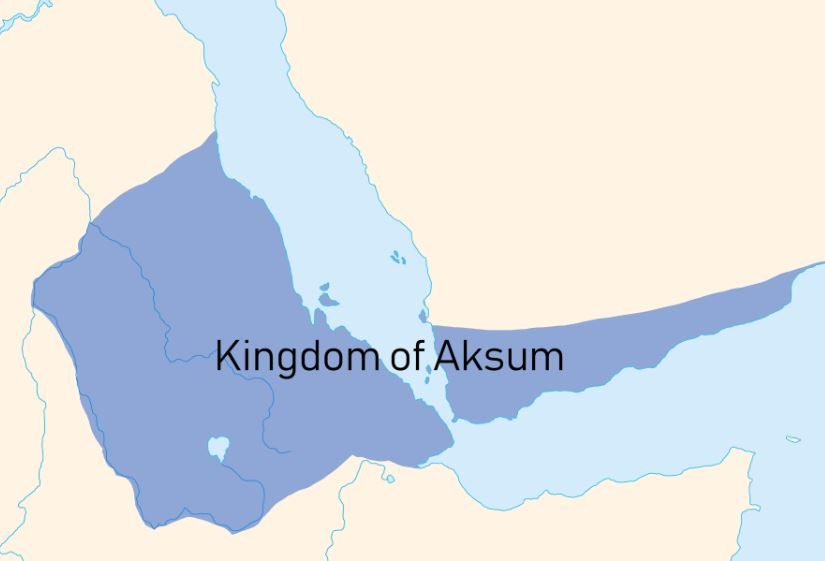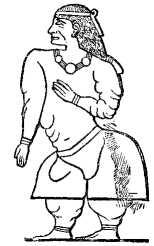Zeila is not merely bordered in the east, but also to the west and northwest borders an Ethiopian and Eritrean territory referred to as “Al-Habash”. Typically this refers to the Christian Highland peoples between the coast and Ethiopia proper, but in our context we will use this to refer to “modern Eritrea”. This Habash likely comes from the ancient root “HBST”, or Habasat in native Eritrean Ge’ez. The difference between this region and Zeila is that it occupies the coastal regions directly opposite Yemen in the strait of the Bab-el-Mandeb. This would give those who controlled it complete dominance over trade; while Zeila functioned more like a middle man, the Al Habash area was strategically crucial to imports for the entire Red Sea coast.
Ultimately these “Habash”, or Habasat are probably the local Axumites. Axum, variously spelled “Aksum”, was arguably one of the first christian kingdoms in the world with strong ties to the Semitic speakers of Arabia, especially Yemen. Second or third century Sabaean Inscriptions from the Yemeni Sabaeans across the straight record a negus1 named GDRT of Aksum and HBST. The term “Habasat” is likely a foreign exonym for the native term “Habesha”. From this term came the Latin name for the region - and later English term - Abyssynia.
While the region in Egyptian sources was referred to as “Punt”, in records regarding trade with the people of Punt the term “ḫbś.tj.w” appears, containing the “HBST” lettering. This term means “bearded ones”, and may be the source of the Semitic term for these people, rather than being an endogamous term.2 Pottery depicted on ships coming from Punt during the reign of Pharaoh Amenhotep II looks similar to the long-necked pottery found at the oldest East African archeological site, Simbel, located in the Habash region. Aksum was a major power during its time, conquering most of the Red Sea coast and parts of Yemen even conquering and wiping out the remainders of the Kushites at Meroe, attesting to some sort of geographic shared borders, and “Cushite” lineage. Notably, Aksum did not control Zeila or any “Somali” territory, helping us attest to Aksum and “Somalia/Zeila” (possibly Havilah) as separate regional polities.
What is unclear are the exact origins of Axum and their Semitic speakers. Prior to Aksum there existed the more ancient Kingdom of D’mt, pronounced “Damot”. Damot was established around the year 980 BCE, making it quite an ancient polity and likely lining up with our Bronze Age timeline. Due to the presence of a large temple complex located at the site of Yeha, the tentative location for the “Damotian” capital is considered to be at Yeha.3 Many of the god names being worshiped in Damot show indication of native origin, but also foreign southern Arabian gods are being worshiped in the region. According to sources from Ethiopia in the Kebra Nagast, one of their most holy works, around the year 1000 BCE during the reign of King Solomon, the Queen of Sheba’s son Menelik I - a son between her and Solomon - is said to have migrated to this region. Ethiopeans regard this as the historical account of their founding, and it certainly confirms some Semitic admixture was occurring.
During this period on the red sea the Semitic speaking Sabaeans dominated the region, and likely represented a large admixture to the kingdom of Damot, if not having outright colonies in the region. This may, or may not, represent the earliest migration of Semitic speakers into the region as well - since the Sabaeans were Semitic speakers - and the Sabaean influence on the region eventually leads to the development of Ge’ez script.4 People such as the Agaw, who are a strikingly “Hebraic” people and progenitors of many of the Beta Israel, may represent some of the earliest Jewish waves, but this is unclear.
Interestingly, a low caste tribe in Somalia, related to the Sab people, are the Yibir. The Yibir occupy work traditionally seen as “impure” such as leather working, medicine making, or the creation of amulets and practice of magic. The Yibir are normally considered a “Jewish” group that was forcibly converted in later centuries.5 This helps attest to a Jewish presence in the region that predates Islam, and the modern “Samaale” Somalian identity.
Whether or not the “Queen of Sheba” was the “Queen of the Sabaeans” is a discussion for later chapters, when we reach the origins of the Yemenis, but for now it’s obvious archeological records and religious oral tradition line up. While most of Damot’s history remains a mystery, it helps explain why the region contains some duplicate entries from the sons of Shem since the region became ethnically blurred between “Cushites” and “Semites”.
One may assume that after discussing Eritrea, Somalia, Zeila, and even parts of Ethiopia we would have fully painted the ethnic background of the region. That would be incorrect, as the nation of Djibouti actually has an ancient history, distinctly separate from both Zeila and the Semitic, Ge’ez speakers of Damot and Aksum. The modern city and people of Djibouti only trace their identity to the 1800s, but the region was occupied and controlled whether natively, or by foreign powers since at least the Bronze Age. Before this period, the region had a Mediterranean climate that made it very habitable, but by 1500 BCE the water resources in the area began to dry up. This is likely true for the wider “Punt” area, which Djibouti would traditionally have been inside from an Egyptian perspective.
It’s possible the origin of the name “Djibouti” comes from the Egyptian term “Land of Tehuti” - alternatively spelled Djehuty - meaning Land of Thoth. While once a notable region to Egypt, mentions of Punt ceased after the Bronze Age, indicating some sort of decline in the region. What we essentially see is that during the Pharaonic period of Egypt, the broader Punt geographic region declined drastically. What was once a luscious, food-filled wetlands became dry, and arid. There have been suggestions that the Pharaohs, and their Dynasties, originally came from the Land of Punt themselves, possibly explaining why Punt was referred to with an almost mythical lens by the Egyptians. This is an unlikely theory based on archeological records of Egypt, but it’s possible a noble line did trace themselves to Punt.
Egyptian Temple murals from Deir el-Bahari depicting the Land of Punt region show they were at one time ruled by a King ‘Parahu’ and his Queen ‘Ati’; pictured by the figures in the above image, and the figures depicted here. It’s clear these Puntians were not Nilotics based on the way Egypt depicts them starkly different from the Nubians.
In Greek sources, possibly referring to this region including Somalia, the area is variously recorded as the land of the “Macrobians”. While very little is known about these Macrobians, where they lived, or much about their culture, we know from Herodotus that they occupied the Horn of Africa, and practiced some form of complex embalming of their dead. He also describes them as the “tallest and most handsome among all men”.6 He calls them fierce warrior herders, and wealthy seafarers, lining up with accounts of the Somalis who fit both of those descriptions. These identifications help clue us in that the Macrobians to the south are likely Somali, inhabiting regions south of Zeila.
Finally, many of these people might have emerged from the earlier Jebel Mokram culture around 1800 BCE. This culture produces pottery that’s quite similar to that of the aforementioned Kerma, possibly indicating they both descended from a common area, or shared their technologies. Back even further in a similar region as the Jebel Mokram culture is the ‘Gash Group’ culture, located along the Gash river in the year 3000 BCE through 1800 BCE. Like the Jebel Mokram, the Gash also has some pottery influence from the Kerma culture, but markedly less so.7
Uncertain where this fits, I would also like to mention the city of “Hawila” in Sudan, close to Khartoum and Soba.8 If the original Havilah came from that Hawilah, or how the city got that name is unclear. More etymological work will be necessary.
When deciding where to place Havilah, there is no reason so far to suggest Havilah was not located where most scholars presume, around the city of Zeila. The question becomes how far the boundaries extend in either direction. The extent of these borders depends on the other various regional polities and tribes as we have discussed at length.
If we were to identify the major groups of “Cush” briefly, they would be as follows: The Kermites of Lower Nubia who make their way to Upper Nubia in the Kushite period; the Nilotics of Upper Nubia who due to their pastoralist ways migrate to a more centralized location around Khartoum/Soba from Meroe/Saba following the Meroitic period, the proto-Aksumite D’mt Kingdom, possibly contiguous with the territory of Punt prior to the Bronze Age; the proto-Somali dominating the Horn and trading goods from southern Africa and India up the Red Sea.
If we earlier placed Seba as the Nilotic founder, and Cush was the founder of Kerma; then the decision would be clear that Havilah does not represent the Aksumites, or South Semitic Ethiopians, but rather the Somali and Horner peoples.
This concludes our analysis of Havilah, and we will continue with Cush’s children looking at Sabtah next. Thank you once again for reading and don’t be afraid to comment any criticisms or questions!
The term for King.
Breyer, Francis (2016). "The Ancient Egyptian Etymology of Ḥabašāt "Abessinia"" (PDF). Ityop̣is. Extra Issue II: 8–18
Shaw, Thurstan (1995), The Archaeology of Africa: Food, Metals and Towns, Routledge, p. 612, ISBN 978-0-415-11585-8
Munro-Hay, Stuart (1991). Aksum: An African Civilisation of Late Antiquity. Edinburgh: Edinburgh University Press. pp. 61–62. ISBN 0748601066.
Fisher, Ian (August 15, 2000). "Djibouti Journal; Somalia's 'Hebrews' See a Better Day". New York Times. Retrieved 2009-09-04.
The Geography of Herodotus: Illustrated from Modern Researches and Discoveries by James Talboys Wheeler pg 528. The British Critic, Quarterly Theological Review, And Ecclesiastical Record Volume 11 pg 434
Andrea Manzo: Eastern Sudan in its Setting, The archaeology of a region far from the Nile Valley, Archaeopress 2017, ISBN 9781784915582, 33 online







